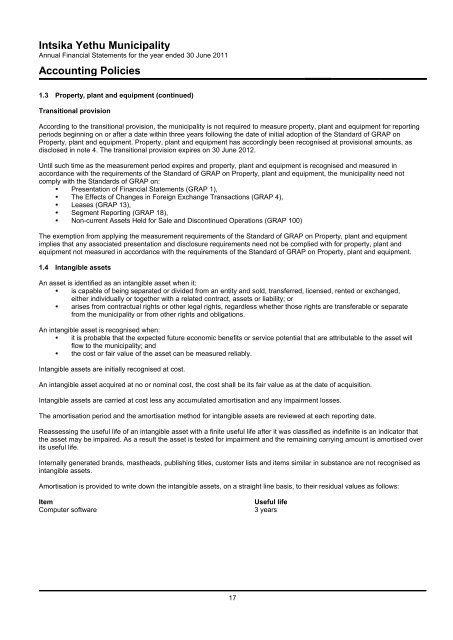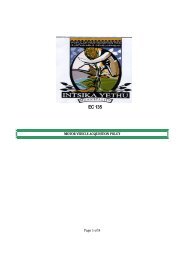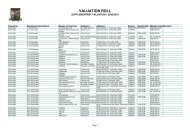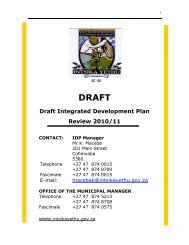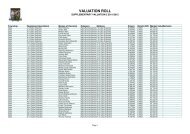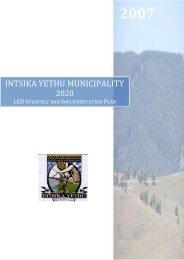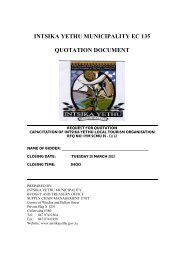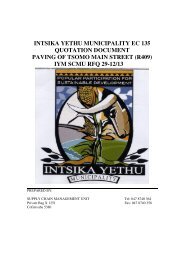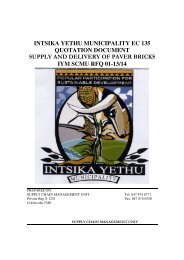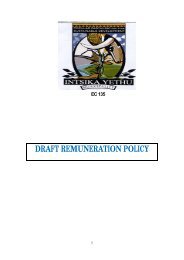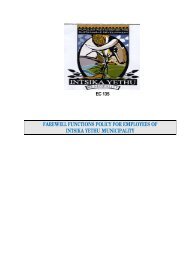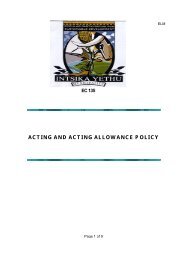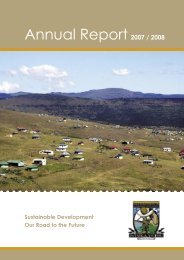annual report 2010 - 2011 - Intsika Yethu Municipality
annual report 2010 - 2011 - Intsika Yethu Municipality
annual report 2010 - 2011 - Intsika Yethu Municipality
You also want an ePaper? Increase the reach of your titles
YUMPU automatically turns print PDFs into web optimized ePapers that Google loves.
<strong>Intsika</strong> <strong>Yethu</strong> <strong>Municipality</strong><br />
Annual Financial Statements for the year ended 30 June <strong>2011</strong><br />
Accounting Policies<br />
1.3 Property, plant and equipment (continued)<br />
Transitional provision<br />
According to the transitional provision, the municipality is not required to measure property, plant and equipment for <strong>report</strong>ing<br />
periods beginning on or after a date within three years following the date of initial adoption of the Standard of GRAP on<br />
Property, plant and equipment. Property, plant and equipment has accordingly been recognised at provisional amounts, as<br />
disclosed in note 4. The transitional provision expires on 30 June 2012.<br />
Until such time as the measurement period expires and property, plant and equipment is recognised and measured in<br />
accordance with the requirements of the Standard of GRAP on Property, plant and equipment, the municipality need not<br />
comply with the Standards of GRAP on:<br />
Presentation of Financial Statements (GRAP 1),<br />
The Effects of Changes in Foreign Exchange Transactions (GRAP 4),<br />
Leases (GRAP 13),<br />
Segment Reporting (GRAP 18),<br />
Non-current Assets Held for Sale and Discontinued Operations (GRAP 100)<br />
The exemption from applying the measurement requirements of the Standard of GRAP on Property, plant and equipment<br />
implies that any associated presentation and disclosure requirements need not be complied with for property, plant and<br />
equipment not measured in accordance with the requirements of the Standard of GRAP on Property, plant and equipment.<br />
1.4 Intangible assets<br />
An asset is identified as an intangible asset when it:<br />
is capable of being separated or divided from an entity and sold, transferred, licensed, rented or exchanged,<br />
either individually or together with a related contract, assets or liability; or<br />
arises from contractual rights or other legal rights, regardless whether those rights are transferable or separate<br />
from the municipality or from other rights and obligations.<br />
An intangible asset is recognised when:<br />
it is probable that the expected future economic benefits or service potential that are attributable to the asset will<br />
flow to the municipality; and<br />
the cost or fair value of the asset can be measured reliably.<br />
Intangible assets are initially recognised at cost.<br />
An intangible asset acquired at no or nominal cost, the cost shall be its fair value as at the date of acquisition.<br />
Intangible assets are carried at cost less any accumulated amortisation and any impairment losses.<br />
The amortisation period and the amortisation method for intangible assets are reviewed at each <strong>report</strong>ing date.<br />
Reassessing the useful life of an intangible asset with a finite useful life after it was classified as indefinite is an indicator that<br />
the asset may be impaired. As a result the asset is tested for impairment and the remaining carrying amount is amortised over<br />
its useful life.<br />
Internally generated brands, mastheads, publishing titles, customer lists and items similar in substance are not recognised as<br />
intangible assets.<br />
Amortisation is provided to write down the intangible assets, on a straight line basis, to their residual values as follows:<br />
Item<br />
Computer software<br />
Useful life<br />
3 years<br />
17


